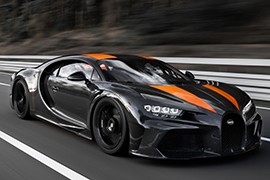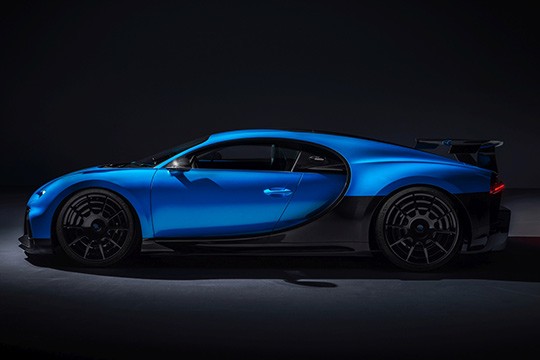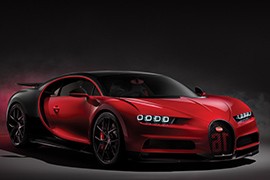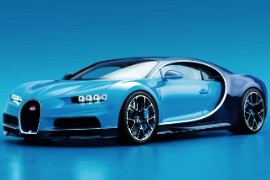BUGATTI Chiron Models/Series Timeline, Specifications & Photos
First production year: 2016
Engines: Gasoline
Body style: Coupé (two-door)
With a top speed of 300 mph (490.484 kph), this is not only the fastest Bugatti ever built, but also the fastest production car on the planet as of September 2019. The heavily modified Bugatti Chiron received a longer back and some extra power from the engine. Also, the “Longtail” back has an important role for aerodynamic efficiency.
Longer, meaner and more powerful, the Chiron Super Sport 300+ was specifically built for the 300 mph car title, and has taken the crown. Also, it is considered a production car, not a unique model, which makes the prize even more valuable.
The modified W16, 8-cylinder engine with four turbochargers develops 1578 hp. Since more internal components are carried-over from the Centodieci (110) model, the gearbox and transmission are the same, with an 8-speed automatic gearbox and all-wheel-drive. An interesting fact is that Bugatti made a record-run with the prototype at 304 mph, it then installed a 300 mph speed limiter for the production model.
Only 30 units will be made, with the first one having been sold right when the car was launched. The customer actually signed the papers on top of the first car's roof. The launch of this new model was showcased with the occasion of the finale of the Grand Tour, a rally that payed an homage to Ettore Bugatti's life, from Milan to Paris via Molsheim. The price tag is a staggering 3.5 million euro.
It is built for sports and performance. The luxury inside is not at the same level at its siblings, but the new Chiron Pur Sport has more things in common with a race car than the other Chiron versions.
The biggest visual difference is the huge 1.9 m (6.2 ft) wing in the back. It is fixed and will stay there even if the car will go 400 kph (248 mph). Another interesting feature is the exhaust, which is 3D printed out of titanium. This production method gives the components very thin walls.
Inside the hypercar there is a combination of Alcantara and carbon fiber. The trims have been reduced to a minimum. Dynamic patterns have been engraved with laser into the door trims to contrast fabric highlights with a metal look. The steering wheel is covered in Alcantara for maximum grip, and at 12 o'clock there is a mark.
The 8.0-liter W16 engine has 1500 hp and 1600 Nm (1180lb-ft) of torque. Even though the Chiron coupe has the same output data, the Pur Sport's engine is slightly different. It has an increase in the maximum rpm limit by 200 rpm, up to 6900. To get even better performance, the gearbox received different gear ratios, with shorter gaps between the seven speeds available. One of the results is that the 60 -120 kph (37-74 mph) acceleration is two seconds faster than Chiron Coupe. The price for the 60 units is three million euros, plus tax.
Ever since Bugatti revived with the Volkswagen group's help, it only offered hypercars with over 1000 hp under the hood. The Chiron was no exception.
In 2016, Bugatti introduced a particular version for the Chiron range. It was the Chiron Sport, like if the regular Chiron was not enough. But this one was a little different. At the front, the four rectangular, LED headlights looked mean in their sharp enclosures. On the grille, shaped like a horseshoe, the carmaker painted the number 16, resembling the car's W16 engine. From its sides, the car reached the Veyron, while in the back, the carmaker installed an adjustable wing. Compared to the regular Chiron, the Sport version was lighter by 18 kg (36 lbs) than the standard version.
Inside, Bugatti couldn't go otherwise than with full luxury and expensive materials. It used sued leather for the gear selector and the steering wheel, smooth leather for the seats, the islands on the dashboard, including the instrument cluster trim, and door panels. Some carbon-fiber accents were installed on the center console.
Under the hood, it was the same quad-turbo W16 engine, pumped up to 1500 hp. It sent the power in all corners via a 7-speed automatic (dual-clutch) gearbox. Its performances were not too much improved when compared to the standard Chiron, but due to the improved suspension and aerodynamic, it was better on the corners.
After Volkswagen bought Bugatti, the evolution of the French brand was astonishing, starting with the introduction of the Veyron in 2005. But after eleven years, the car manufacturer brought its successor: the 2016 Chiron. It was a marvelous piece of engineering that stunned the world with its caped top speed of 420 kph (261 MPH). The automaker didn't limit that speed there because the engine couldn't do more but because there were no tires in the world to withstand more than that without ripping apart.
When an automaker decides to create a vehicle that's gonna replace a successful model, it faces many challenges. So, when Bugatti decided to replace the Veyron, its successor had to be even better. That meant more power, a more elaborate design, and a cabin that could be better in any way than its predecessor, which, by all means, was on top of the world in all aspects.
The result was the Chiron. Bugatti unveiled it at the 2016 Geneva Motor Show, but it was preceded by several other concept cars, such as the Vision Gran Turismo, which had its premiere just six months before the release of the final product. The vehicle's front end was dominated by the shoe-horse shape of the radiator that took center stage. It resembled the same element from the pre-WWII Bugatti vehicles built at Molsheim in France. It was flanked by the narrow, LED headlights that featured four distinctive lamps on each side. On the lower side, in the bumper, the automaker placed two broad air intakes that increased downforce and cooled the front brakes. From its profile, the Chiron was unmistakable with its two-tone paint job, where the front sported a color and the rear, usually black. But, of course, customers with hugely deep pockets could order the vehicle in any color they desired. At the back, the rear quarter panels were huge, featuring broad shoulders over the fat rear tires. They started with a C-shaped line that resembled the mighty Bugatti Atlantic from the '30s. Finally, at the rear, the automaker placed the taillights on a light strip that crossed the car from side to side and, underneath them, a bumper fitted with two center-mounted, massive exhausts. Yet, those were not the only ones. The automaker included another two round pipes in the car's rear diffuser.
But Bugatti has always been a luxury brand, so it couldn't let the interior look mundane. As a result, the Chiron boasted a lavish leather-wrapped cabin where the carmaker installed a pair of high-bolstered sports seats. Between them, a tall center console created the impression of two individual sections: one for driving and one for relaxation. Moreover, a C-shaped element ran on the headliner to the rear cabin's panel only to reach the center console in a harmonious arch, amplifying the sensation of separation between the driver and the passenger area. Fronting the driver was a part-digital instrument cluster with an analog, center-mounted speedometer flanked by two LCDs that showed various information about the car, including the tachometer.
But the magic happened behind the cabin, in the engine compartment. Bugatti installed a W16 eight-liter powerplant. It was helped by four turbochargers to get a maximum power of 1500 PS (1480 HP), which were delivered in all corners via a seven-speed automatic (dual-clutch) transmission using a Haldex center differential.



